10 Tray Convection Oven-CS-1064
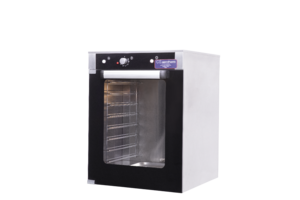
Move over deck ovens, this compact convection oven is the next in thing for small to medium sized bakeries. Ideal for baking all types of bread, cookies, croissants, puffs etc. Stainless steel trays for healthy baking. Uniform baking gives a perfect touch to the end product. It's sleek design doesn't occupy much space. It comes with a steam function which enables you to make cupcakes, fruit cakes, sponge cakes of different flavors. Gas consumption is less than a kilogram in an hour. Eco-friendly and easy to clean and maintain. You can even make tandoori items, baked dishes like garlic bread, croissants, pizzas, steamed items as dhokla, idli , sponge cake, scrumptious desserts such as pudding, kheer. Widen your horizons and grow your business.
Introduction
This contains the detailed information about 6 tray convection oven
Safety Signs
- Danger! Immediate danger (Yellow background, black borders, and drawing)
- Attention! Fire hazard (Yellow background, black borders, and drawing)
- Attention! Presence of electrical voltage inside! (Yellow background, black borders and drawing)
- Attention! Fire hazard! (Yellow background, black borders and drawing)
- Equipotential ring (Grey background, black borders and drawing)
- Terminal black (Yellow background, black drawings)
General instructions and warnings
- It is very important to read this manual carefully in order to install and service the equipment described correctly. All ovens manufactured by us are intended for professional cooking or heating of food.
- Make sure the electrical distribution values match the values shown on the technical plate.
- The electrical safety of these devices is assured by the connection to an efficient earthing system, according to the laws in force.
- Failure to comply with this essential rules might affect the safety of the user and the proper operation of the equipment.
- Do not tamper with the guards and the safety devices installed on the oven.
- Do not remove the guards and do not deactivate the safety devices installed on the oven unless for carrying out the maintenance.
- Reinstall all guards and reactivate the safety devices as soon as the temporary reason for which they were removed.
- Do not use the oven for other purposes and/or with other loads than those indicated by the manufacturer.
- Carry out daily checks on the safety devices.
- Perform thorough and adequate daily cleaning.
- Do not use solvents, corrosive or toxic agents to clean the oven.
- Adopt all necessary safety measures during loading, adjustment, replacement, cleaning, repair, maintenance to make sure the oven is installed and used.
Oven Characteristics
The oven was designed for cooking a wide range of pastry products.
It is designed for cooking and heating food.
Main Components of the Oven
- Handle
- External glass
- Internal glass
- Rack holder
- Fan
- Dashboard front panel
- Dashboard
- Stainless steel lateral side
- Gasket
- Oven foot
- Conveyor
- Back
- Open close Chimney
Technical Specifications
| Details | Specifications |
| Model | CS-1064MC-GAS |
| Maximum Temperature (° C / ° F) | 300 / 572 |
| Capacity (No of Trays) | 10 |
| Tray size (L x W) in mm / inches | 600 x 400 / 24 x 16 |
| Installed Power (KW / HP) | 1.5 / 2 |
| Voltage and Phase (Volts / Phase / Hertz) | 230 / 1 / 50 |
| External Dimensions (W x D x H) in mm / inches | 977 x 928 x 1193 / 38.5 x 36.5 x 47 |
Transportation and Unpacking
The oven is supplied in a pallet, fixed to it by plastic straps and protected by a cardboard and nylon wrapping. Load/unload the oven from the means of transport using a lifting truck, trolley.
Instructions For Transport And Unloading
Loading and unloading from the transport means can be carried out using a forklift truck.
- The oven shall be transported safely taking all necessary precautions.
- During transport, pay particular attention not to damage the "surroundings" such as columns, walls, other machines etc.
- Do not place the oven on top of other materials and do not place other materials on top of the oven during transport or storage.
- Secure the oven during transport to make sure that it does not hit any other materials loaded in the same vehicle.
- Before unloading the oven from the vehicle make sure the packaging is intact and it does not tip over.
- Place the oven gently on the ground without hitting it.
Daily startup
Before starting the oven
- Read carefully all sides of the manual.
- After removing the oven from its package, make sure it is intact and check for any visible damages.
- The packaging materials (plastic, nails, screws, wood, etc) must be gathered in appropriate collection points.
- The oven must be placed on a levelled, stable surface.
- There should be no objects inside the oven.
- Check that all guards and safety systems are installed and functioning.
- Make sure the electrical connection is correct.
- Make sure the line voltage of the socket where the plug of the oven supply cable will be inserted, matches the one declared by the manufacturer and shown on the identification plate.
- Make sure that the water supply connection is correctly made and that there are no leaks.
- Make sure the vapours exhaust system is free and connected correctly. Ensure the cooking chamber is connected to the exhaust system.
Oven Start up
To use the oven proceed as follows:
- Check the compatibility between the main voltage and the voltage of the oven.
- Start the oven and test its baking functions, the timer and the selectors as well as all signal lights.
- Make sure the door lights and the fan work properly.
- Before cooking any food you have to let the oven run empty for half an hour at about 180°C.
- This is to remove and burn any residual oils.
Use of the oven
For better understanding of the control see the definition of the operating modes below:
Key functions
Switched off: The oven is not powered. Oven is powered form manual operations or select one of the previously configured recipes.
If the oven is ON, it is ready to receive the commands from the control panel.
ON/OFF:
Press once to start or stop the oven.
Even if the oven is off, the button remains lit to indicate that the oven is powered. Before carrying out any maintenance operation disconnect the plug, cut off the power supply and wait for the button to turn off.
Temperature:
With the oven ON, press once to set the baking temperature and/or confirm a value.
With the oven ON, press once to set the baking time. 22
Start / Stop:
With the oven ON, press once to set the start/end a baking cycle.
You can also use this command to quickly lower the temperature in the cooking chamber: e.g. open the door and hold the button for more than 3 seconds. To ease this operation, the chimney is also opened and the fans are rotated at maximum speed; you can monitor the temperature decrease on display 2.
Manual Operation for preheating
Preheating enters into action, at the beginning of each cooking, both manual and automatic.
It consists of heating the cooking chamber to a given temperature.
Manual preheating will terminate when the oven reaches to the desired cooking temperature which is the sum of the set temperature and the 30° relative to the preheating temperature.
Pressing the START &- STOP button starts the preheating of the oven.
Upon reaching the set temperature the oven emits a signal sound and display changes from "PRE" to a flashing "END".
At this point, open the door (at which the signal sound stops) and put the food inside the oven, then close the door. When one opens the door display indicates OPEN. The oven will begin the cooking cycle and one can now set the cooking time and the manual humidification.
Manual Operation for START/STOP command
Press the key START / STOP button to start the baking cycle. This way you will activate the MANUAL function for heating, ventilation and humidification.
By pressing the key START/STOP you can block the baking cycle at any time. Press it again to restart the oven cycle from the beginning.
You can monitor the temperature decrease on display. The set baking temperature and time values remain available for a possible new baking.
Maintenance
The interventions can belong to routine or extraordinary maintenance
Every maintenance intervention, periodic or not, contained herein shall be considered routine maintenance, unless otherwise specified; all other interventions, not included herein, shall be considered extraordinary maintenance interventions; if in doubt contact the manufacturer.
Disconnect the power supply cable
The disconnected plug remains visible so that everyone, especially the operator, can check if the oven is powered or not; this is to prevent any accidental start-up of the oven.
If for a certain intervention you need to remove a guard or to deactivate a safety device, please adopt appropriate safety measure to protect other person from the consequences (e.g. cordon the area with chains and place warning signs for the work in progress);
All guards must be restored and locked with the intended fixing means and all safety devices must be reactivated as soon as the reasons for their removal/ deactivation disappeared.
The manufacturer shall not be held liable for any damages to persons, animals or things due to failure to comply with the instructions herein and/or to improper or non compliant use of the oven.
Possible faults or failures
Below you can see some of the possible faults or failures:
| Faults or Failures | Possible causes | Solutions |
|---|---|---|
| The oven did not start | No power supply | Make sure the plug is correctly inserted in the socket. |
| The oven did not start | Safety thermostat failure | Replacement of the safety thermostat. |
| Faulty Motor | Overheating | Check the current arrives to the motor |
| After pressing START/STOP the oven does not start | Door incorrectly closed or open | Check if the door is closed |
| After pressing START/STOP the oven does not start | Door incorrectly closed or open | Contact the technical support centre |
| Incorrect temperature detection | Faulty baking thermostat | Replacement of regulation thermostat |
| Incorrect temperature detection | Thermostat bulb out of its housing | Place it back in its housing |
| Cooking chamber heating does not start | Baking temperature faulty or damaged | Thermostat replacement |
Cleaning and Disinfection
Before starting any operation, adopt the safety measures described .
The oven must be in proper hygiene conditions as envisioned by the laws in force thoroughly cleaned and disinfected both on the outside and on the inside at the end of every day and/or work shift.
Clean it and disinfect it every day to avoid any biological risks due to formation of mold, bacteria, etc, or due to incrustations that might affect the operation of the oven.
Each routine maintenance operation shall be performed:
- After disconnecting the oven from power supply
- After adopting all necessary PPE (e.g. gloves, boots etc.)
IMPORTANT
Wear appropriate PPE during installation such as anti abrasion gloves and safety shoes
- Do not use abrasive detergents.
- Do not use aggressive or corrosive detergents.
- Do not use these substances to clean the surface under the oven either.
- Do not use sharp abrasive tools.
Safety
The information in the next chapter is based on the presumption that:
- The operator read and understood the instructions and indications herein and knows the conditions and the destination of use of the oven.
- The workers authorised to use the oven were properly informed on the specific risks existing in the workplace, according to the laws and regulations in force.
- The workplace cannot be accessed by unauthorised persons, untrained persons and children.
Dangers and Risks
As per Directive 2006/42/CE we offer below information on the oven- related hazards, on the corresponding risks and the measures adopted to reduce or eliminate them; if a certain risk was not eliminated, we offer you information on the relative residual risk and on additional measures that should be adopted by the user in order to limit it.
Oven-Related Risks
The oven is characterised by the following hazards: •Biological
- Fire hazards
- Electric shock hazards
- Burn hazards and risk of injury
- Due to failure to comply with the ergonomic principles.
Dismantling
Dispose of the oven according to the laws and regulations in force.
Please contact specialised waste disposal companies so that they can carry out the work in compliance with the applicable laws and regulations in force.
Examples of materials that are part of the oven
- Stainless steel such as lateral metal sheets.
- Plastic such as the encoder
- Rubber such as the gaskets
- Various materials such as the motor (copper windings), electrical components.
- Wool (contact special waste disposal companies.
For disposal proceed as follows
- Remove the power supply cable.
- Remove all mobile parts that might pose a risk.
- Dispose of most of them as iron scrap and place them in the collection centres set by the regulations in force.
- Other parts, such as plastic, must be disposed of according to the regulations in force, contacting, if necessary specialised companies.
Electrical Drawings

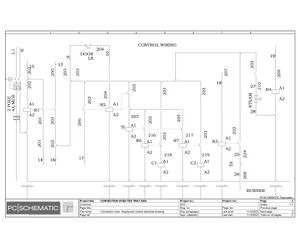
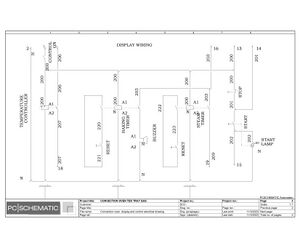
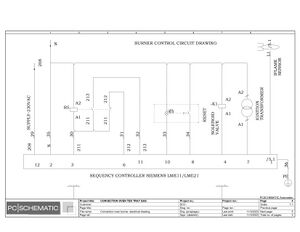
Exploded View Drawings
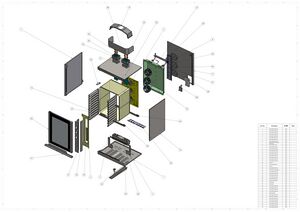
Contact Details
Mechtrace by CS Bakery Solutions.
Address: 143 H, Bommasandra, Industrial Area,
Hosur Road, Bangalore - 560 099, India.
Tel: +91 80 40895000
Email: contactus@mechtrace.com
